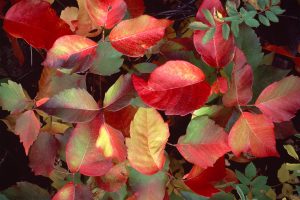Beware of poison ivy in the fall

Poison oak leaves in the fall
What could happen if your skin is exposed to poison ivy?
After being exposed to poison oak, poison ivy or sumac, many people get a very itchy blistering rash. The rash is caused by uroshiol, an oil found in these plants. The rash occurs a few hours or up to a few days after exposure. Patients usually develop itchy red swollen skin, blisters and hives. The rash can be very itchy and can spread by direct contact through clothing or touching the plant, indirect contact such as through pets and gardening tools, and even by airborne contact when plants are burned.
How to treat a rash from poison ivy
- If the rash is severe, if there is swelling of your face or eyelids, or if you have trouble breathing or swallowing you should go to the emergency room.
- For milder rashes, the affected skin should be rinsed with warm soapy water.
- Clothing and any products that have been in contact with the plant should be washed well in hot soapy water.
- Cool compresses, calamine lotion, over-the-counter hydrocortisone cream and over-the-counter antihistamines will help relieve the symptoms.
- Try to leave the blisters alone as scratching can cause infections
- If your rash is not improving, see a board certified dermatologist.
How to prevent rashes from poison ivy
Try to avoid poison oak poison ivy and poison sumac altogether. Wear protective clothing including long sleeve shirts gloves long pants and boots. A skin cream called an ivy block barrier and containing bentoquatam, can be bought over-the-counter, and will help protect any exposed areas of skin.
While you may associate poison ivy with spring and summer, our dermatologists advise to remain on the lookout for poison ivy this fall. You may be tricked by their beautiful fall color while apple picking this season. Beware!
You may also like:
– How to prevent poison ivy rash, a springtime curse
– Dr. Kenneth Arndt on poison ivy for the Harvard Health Letter



Leave a Reply